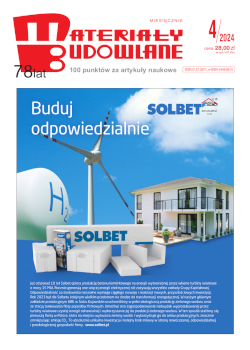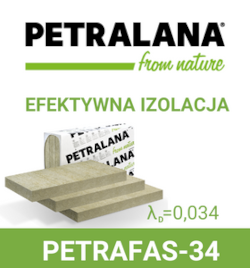mgr inż. arch. Michał Gołębiewski Politechnika Warszawska,Wydział Architektury
Autor do korespondencji e-mail : Ten adres pocztowy jest chroniony przed spamowaniem. Aby go zobaczyć, konieczne jest włączenie w przeglądarce obsługi JavaScript.
DOI: 10.15199/33.2016.07.29
Hempcrete to kompozytowy materiał budowlany, w skład którego wchodzą paździerze konopne, spoiwo wapienne, woda oraz ewentualne dodatki. Naturalne pochodzenie materiału, niewielki nakład energii potrzebnej do jegowytworzenia, awefekcie niski poziom emisji CO2 w całym cyklu życia oraz możliwość poddania procesowi całkowitego recyklingu powodują, że w połączeniu z bardzo dobrymi parametrami ochrony cieplnej jest to materiał ekologiczny, mogący wnieść istotny wkład w rozwój zrównoważonego budownictwa. Hempcrete obejmuje technologie różniące się: sposobem wykonania elementów budynku; charakterystyką i proporcją komponentów użytych do otrzymania kompozytu oraz sposobemjego wytwarzania. Z uwagi na te różnice, właściwości materiału zawierają się w bardzo szerokim zakresie.
Słowa kluczowe: hempcrete, kompozyt konopno-wapienny, ekologiczne materiały budowlane, budownictwo zrównoważone.
* * *
Hemp-lime composites (hempcrete)
Hempcrete is a composite constructionmaterial, generally consisting of hemp shiv (hurd), lime–based binder,water and alternative additives. Natural origin of the material, its low embodied energy and consequently low CO2 emission in a whole life- cycle, its full recyclability and high thermal insulation properties makes the material truly ecological, possibly making important contribution to development of sustainable construction. Hempcrete technology is a wide-ranging definition which includes methods differing in: a way the elements of buildings are being done, characteristics and proportions of the components used to production of the composite and methods applied to its formation. Due to the aforementioned differences, properties of the material fall within a wide range.
Keywords: hempcrete, hemp-lime composite, ecological construction materials, sustainable construction
Literatura
[1] Allin Steve. 2012. Building with Hemp. Ireland. Seed Press.
[2] Benfratello S., C. Capitano, G. Peri, G. Rizzo, G. Scaccianoce, G. Sorrentino. 2013. „Thermal and structural properties of a hemp–lime biocomposite”. Construction and Building Materials 48: 745 – 754.
[3] Bevan Rachel, Tom Woolley. 2010. Hemp Lime Construction: A Guide to Buildingwith Hemp Lime Composites. United Kingdom. Ihs Bre Press.
[4] Bosca Ivan, Michael Karus. 1998. The Cultivation ofHemp: Botany, Varieties, Cultivation and Harvesting. Sebastopol. CA: Hemptech.
[5] Boutin M-P., C. Flamin, S. Quinton, G. Gosse, L. Inra. 2005. Etude des caracteristiques environnementales du chanvre par l’analyse de son cycle de vie.Ministere de l’Agriculture et de la Peche.
[6] Bouyer T. 2008. De la qualité de matériau béton-chanvre: Rapport destage. ENGREF.
[7] BRE Staff, T. Yates. 2002. Final report on the construction of the hemp houses at Haverhill, Suffolk. UK: Building Research Establishment (BRE).
[8] Cerezo V. 2005. Proprietes mecaniques, thermiques et acoustiques d’un materiau a base de particules vegetales: approche experimentale et modelisation theorique. Report. Ecole Nationale des Travaux Publics de l’Etat, L’Institut National des Sciences Appliquées de Lyon.
[9] Elfordy S., F. Lucas, F. Tancret, Y. Scudeller, L. Goudet. 2008. „Mechanical and thermal properties of lime and hemp concrete („hempcrete”) manufactured by a projection process”. Construction and Building Materials 22: 2116 – 2123.
[10] EvrardA.,A. de Herde, J.Minet. 2006. Dynamical interactions between heat and mass flows in lime–hemp concrete. In: Research in building physics and building engineering, third international building physics conference, Concordia University, Montreal, Canada.
[11] Gielen D. 1997. Building materials and CO2 – Western European emissions reduction strategies: MATTER project report. Energy Research Centre of the Netherlands (ECN).
[12] Gourlay E., L.Arnaud. 2010. Comportement hygrothermique des murs de beton dechanvre. In: Proceedings of the Actes du congres SFT. Le Touquet, France.
[13] Hirst Edward. 2013. Characterisation of Hemp-Lime as s Composite Building Material. Department of Architecture and Civil Engineering, Faculty of Engineering and Design, University of Bath. Great Britain.
[14] Intergovernmental Panel on Climate Change (IPCC). Climate change 2001: mitigation, contribution ofworking group III to the third assessment report of the Intergovernmental Panel on Climate Change. United States of America: Cambridge University Press, 2001.
[15] Instytut Włókien Naturalnych i Roślin Zielarskich (praca zbiorowa). 2013. Technologia uprawy i przetwórstwa konopi włóknistej. Poznań. IWNiRZ.
[16] SheaA.,M. Lawrence, P.Walker. 2012. „Hygrothermal performance of an experimental hemp–lime building”. Construction and Building Materials 36: 270 – 275.
[17] StevulovaN., L.Kidalova, J. Junak, J. Cigasova, E.Terpakova. 2012. „Effect of hemp shive sizes on mechanical properties of lightweight fibrous composites”. Procedia Engineering 42: 496 – 500.
[18] Walker R., S. Pavia. 2012. Impact of water retainers in the strength, drying and setting of lime hemp concrete. In: Proceedings of the BCRI bridge infrastructure concrete research in Ireland, Trinity College and DIT, Dublin, Ireland p. 356 – 360.
[19] Walker R., S. Pavia, R.Mitchell. 2014. „Mechanical properties and durability of hemp-lime concretes”. Construction and Building Materials 61: 340 – 348.
[20] Walker R., S. Pavia. „Moisture transfer and thermal properties of hemp-lime concretes”. Construction and Building Materials 64: 270 – 276.
[21] www.bcb-tradical.com. 05.06.2015 r.
Otrzymano: 01.06.2016 r.
Materiały Budowlane 07/2016, str. 91-94 (spis treści >>)






























